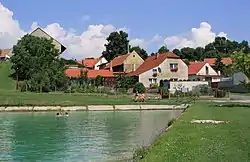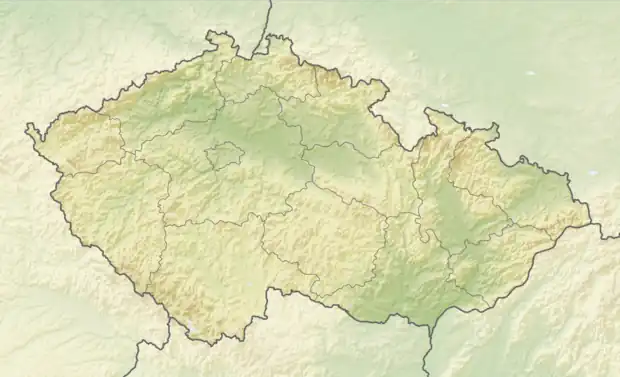Vraný
Vraný is a market town in Kladno District in the Central Bohemian Region of the Czech Republic. It has about 800 inhabitants.
Vraný | |
|---|---|
 Western part of Vraný | |
 Flag  Coat of arms | |
 Vraný Location in the Czech Republic | |
| Coordinates: 50°19′38″N 14°1′2″E | |
| Country | |
| Region | Central Bohemian |
| District | Kladno |
| First mentioned | 1228 |
| Area | |
| • Total | 17.01 km2 (6.57 sq mi) |
| Elevation | 290 m (950 ft) |
| Population (2023-01-01)[1] | |
| • Total | 800 |
| • Density | 47/km2 (120/sq mi) |
| Time zone | UTC+1 (CET) |
| • Summer (DST) | UTC+2 (CEST) |
| Postal codes | 273 72, 273 73 |
| Website | www |
Administrative parts
Villages of Horní Kamenice and Lukov are administrative parts of Vraný.
Geography
Vraný is located about 21 kilometres (13 mi) north of Kladno and 36 km (22 mi) northwest of Prague. It lies on the Lower Eger Table. The highest point is 330 m (1,080 ft) above sea level.
History
The first written mention of Vraný is from 1228, when it was the property of the Basilica of Saint George in Prague. After it changed several less important owners, it was acquired by the Zajíc of the Hazenburk family in 1434, who owned it until 1534. During their rule in 1513, Vraný was promoted to a market town by King Vladislaus II. The market town was badly damaged during the Thirty Years' War and lost most of its inhabitants, but it recovered. From 1706 to 1945, Vraný was owned by the Metropolitan Chapter at Saint Vitus.[2]
In 1980, the municipalities of Horní Kamenice and Lukov were annexed to Vraný.[2]
Sights
The Vraný Castle was built for the Metropolitan Chapter at Saint Vitus in 1764–1769. It is a small late Baroque residence with a Rococo façade. Today it houses a retirement home.[3]
The Church of Saint John the Baptist was built in 1756–1761. It is a late Baroque church, that replaced an old Gothic building that fell into disrepair during the Thirty Years' War. The tower was rebuilt in 1908 by the architect Josef Fanta.[4]
The Church of Saint George in Lukov was originally a Romanesque rotunda, probably from the 13th century. In the 18th century, it was completely rebuilt into its current baroque form.[5]
Notable people
- Jaroslav Věšín (1860–1915), painter
References
- "Population of Municipalities – 1 January 2023". Czech Statistical Office. 2023-05-23.
- "Historie obce" (in Czech). Městys Vraný. Retrieved 2023-03-10.
- "Zámek" (in Czech). National Heritage Institute. Retrieved 2023-03-10.
- "Kostel sv. Jana Křtitele" (in Czech). National Heritage Institute. Retrieved 2023-03-10.
- "Kostel sv. Jiří" (in Czech). National Heritage Institute. Retrieved 2023-03-10.